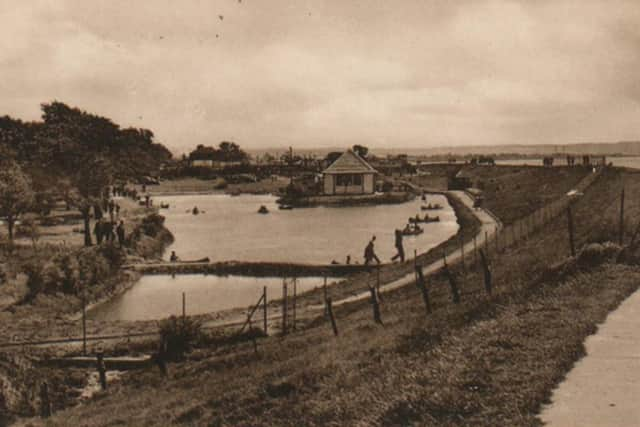We visit the seaside resort near Bristol once called ‘the Blackpool of the West’
and live on Freeview channel 276
Mention Severn Beach these days and most people mention the mud before anything else. They simply don’t believe this quiet spot on the Severn estuary was once a thriving seaside resort with chalets, funfair, boating lake and an outdoor swimming pool called Blue Lagoon.
It's just over 100 years since the first train brought thousands of holidaymakers to the resort, many of them daytrippers from Bristol.
Admittedly, when I visited on a wet and windy winter morning with a yellow weather warning in place, Severn Beach wasn’t looking its best this week. There was certainly no need to pack the suncream and Speedos.
As the two-carriage train from Temple Meads pulled into the single, end-of-the-line platform close to the seafront, the heavens opened and the wind turned storm force. Apart from a few brave walkers with heavy boots and waterproofs, there weren’t many passengers arriving in Severn Beach today.
As I walked along the rain-lashed promenade next to the sea wall overlooking a muddy brown beach the colour of milky coffee, a group of schoolchildren in hi-vis bibs took shelter under a large tree with their clipboard-clutching teachers.
Loading....
The spot where they sheltered was where the old boating lake used to be. It’s covered with grass now but due to heavy rainfall, huge puddles were forming, almost as a soggy reminder of its glorious past.
For me, a trip to Severn Beach has always been something to look forward to. I used to visit the place as a child in the 1970s and my grandparents lived in the nearby village of Pilning.
In those days, the railway station was a grand Victorian building with waiting rooms, toilets and a ticket office. It’s just a platform with a small shelter now.


I still remember sitting in the beer garden of the Severn Salmon pub near the railway station in the baking hot summer of 1976 when the now-legendary swarm of ladybirds descended during the drought. Every white table and chair in the garden was suddenly bright red due to the thousands of ladybirds stuck to them.
The pub has long gone, as have all the other reminders of Severn Beach in its heyday, apart from Shirley’s Cafe, which is still run by the same family who opened it in 1940.
Shirley’s has become something of a museum to Severn Beach’s time as the ‘Blackpool of the West’ and the walls are plastered with black and white photos of the resort.
Even now, and as somebody who went there, it’s hard to believe just how popular the Blue Lagoon swimming pool was. Closed in 1977 and demolished in the early 1980s, thousands of families used to visit the unheated open-air pool, which had diving boards, fountains and water slides.


Between the 1930s and 1960s, there was also a large hotel along the seafront at New Passage, a fairground, cinema, casino and numerous cafes and shops.
There even used to be a strip club called The Beachcomber, which was apparently popular with workers from the nearby ICI chemical plant.
Ask local people when and why Severn Beach lost its previous allure as a holiday resort and they’ll often point to the building of the first Severn Bridge in 1966, which cut off the village at a time when more people were using cars rather than travelling by rail.
They’ll also say that by the 1970s, people were travelling further afield in the UK for their holidays and increasingly buying cheap holidays abroad.


These days, not much happens in Severn Beach. There are a couple of hairdressers, a Morrisons convenience store, a cafe and a bakery and that’s about it.
There are no pubs left and the only place for locals to meet is the 1975-built village hall which offers a range of classes and events, including yoga, zumba, line dancing and a visiting foot care clinic.
As a child, I remember a butchers shop on Beach Road (now the family-run Down’s Bakery) and a hardware shop selling beach balls, inflatables and just about anything else needed for a long, hot day on the pebbly beach with its views of steelworks on the South Wales coast.
In Downs Bakery, I met co-owner Nicola Hills, who’s also part of the local history group. One wall of the bakery has a gallery of old photos of the area, many of which appear in a new book, A Century By The Sea, celebrating 100 years of Severn Beach.


The Downs family moved to the area in 1990 during the building of the Second Severn Crossing. By then, there were very few places to eat in the village so in 1995 they opened the bakery in the former butchers shop, a year before the new bridge opened.
Nowadays, many of the customers are workers from the distribution parks at Avonmouth, which are home to huge operations like Amazon, Royal Mail and Warburtons.
“People can’t believe what Severn Beach was like back in the day,” says Nicola. “It’s amazing how the place has changed over the past 100 years. I have so many people coming in and reminiscing about how they used to come down by train with their bikes and hang out at the swimming pool all day.
“A lot of people who grew up here at the time still live here but those who moved away still come back to see the place for old time’s sake. Severn Beach may have changed a lot over the years but it holds so many memories for people and it draws them back.”
